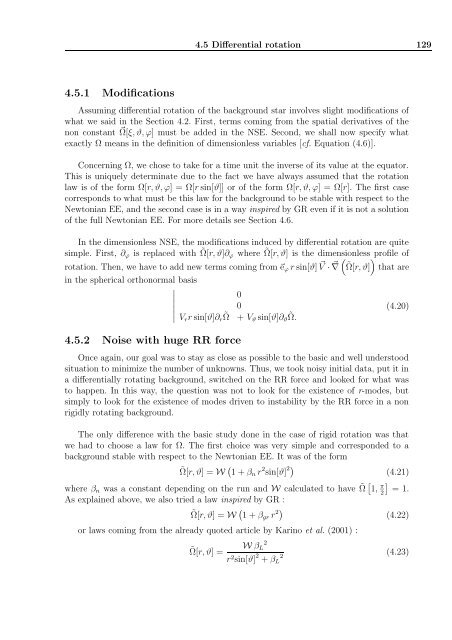Ecole doctorale de Physique de la région Parisienne (ED107)
Ecole doctorale de Physique de la région Parisienne (ED107)
Ecole doctorale de Physique de la région Parisienne (ED107)
Create successful ePaper yourself
Turn your PDF publications into a flip-book with our unique Google optimized e-Paper software.
4.5.1 Modifications<br />
4.5 Differential rotation 129<br />
Assuming differential rotation of the background star involves slight modifications of<br />
what we said in the Section 4.2. First, terms coming from the spatial <strong>de</strong>rivatives of the<br />
non constant Ω[ξ, ϑ, ϕ] must be ad<strong>de</strong>d in the NSE. Second, we shall now specify what<br />
exactly Ω means in the <strong>de</strong>finition of dimensionless variables [cf. Equation (4.6)].<br />
Concerning Ω, we chose to take for a time unit the inverse of its value at the equator.<br />
This is uniquely <strong>de</strong>terminate due to the fact we have always assumed that the rotation<br />
<strong>la</strong>w is of the form Ω[r, ϑ, ϕ] = Ω[r sin[ϑ]] or of the form Ω[r, ϑ, ϕ] = Ω[r]. The first case<br />
corresponds to what must be this <strong>la</strong>w for the background to be stable with respect to the<br />
Newtonian EE, and the second case is in a way inspired by GR even if it is not a solution<br />
of the full Newtonian EE. For more <strong>de</strong>tails see Section 4.6.<br />
In the dimensionless NSE, the modifications induced by differential rotation are quite<br />
simple. First, ∂ϕ is rep<strong>la</strong>ced with ˜ Ω[r, ϑ]∂ϕ where ˜ Ω[r, ϑ] is the dimensionless profile of<br />
rotation. Then, we have to add new terms coming from eϕ r sin[ϑ] V · <br />
∇ ˜Ω[r, ϑ] that are<br />
in the spherical orthonormal basis<br />
<br />
<br />
<br />
0<br />
<br />
<br />
0<br />
Vrr sin[ϑ]∂r ˜ Ω + Vϑ sin[ϑ]∂ϑ ˜ (4.20)<br />
Ω.<br />
4.5.2 Noise with huge RR force<br />
Once again, our goal was to stay as close as possible to the basic and well un<strong>de</strong>rstood<br />
situation to minimize the number of unknowns. Thus, we took noisy initial data, put it in<br />
a differentially rotating background, switched on the RR force and looked for what was<br />
to happen. In this way, the question was not to look for the existence of r-mo<strong>de</strong>s, but<br />
simply to look for the existence of mo<strong>de</strong>s driven to instability by the RR force in a non<br />
rigidly rotating background.<br />
The only difference with the basic study done in the case of rigid rotation was that<br />
we had to choose a <strong>la</strong>w for Ω. The first choice was very simple and correspon<strong>de</strong>d to a<br />
background stable with respect to the Newtonian EE. It was of the form<br />
˜Ω[r, ϑ] = W 1 + βn r 2 sin[ϑ] 2<br />
(4.21)<br />
where βn was a constant <strong>de</strong>pending on the run and W calcu<strong>la</strong>ted to have ˜ Ω 1, π<br />
<br />
= 1. 2<br />
As exp<strong>la</strong>ined above, we also tried a <strong>la</strong>w inspired by GR :<br />
˜Ω[r, ϑ] = W 1 + βgr r 2<br />
(4.22)<br />
or <strong>la</strong>ws coming from the already quoted article by Karino et al. (2001) :<br />
˜Ω[r, ϑ] =<br />
W βL 2<br />
r 2 sin[ϑ] 2 + βL 2<br />
(4.23)
















